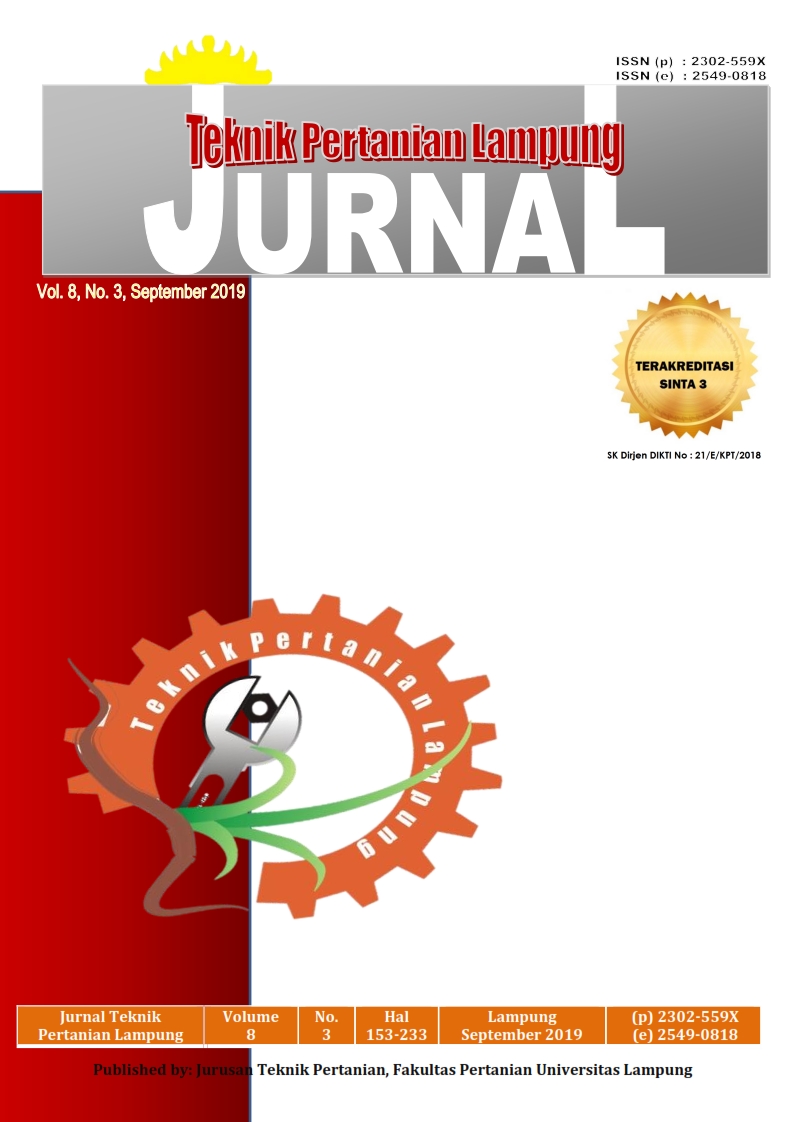ANAEROBIC DIGESTER VARIATION FOR BIOGAS PRODUCTION ON COFFEE WASTEWATER TREATMENT
DOI:
https://doi.org/10.23960/jtep-l.v8i3.164-174Abstract
Wet coffee processing methods will produce waste water containing organic matter. The high content of organic matter can be utilized as biogas through the anaerobic process. Biogas becomes renewable energy source. Anaerobic digesters construction can affect removal process of wastewater pollution and biogas quantity. The research aims was determine the performance biogas production of digester construction on conventional digester, CSTR and UASB from coffee waste water. The conventional digester worked without temperature control system, a UASB digester, and CSTR digester worked with temperature control system. Biomass volume was about 5 L with 35 days incubation time. The research result showed variation of biogas production on each digester. Based on the feeding variations, UASB has a stable performance with 83.57 ml/day of average biogas production. It has also highest remediation efficiency of COD, BOD and C/N with 85.00±0.34 %, 84.40%± 5.66 and 97.78± 0.57.References
Aslanzadeh, S., Rajendran, K., Jeihanipour, A., & Taherzadeh, M. J. (2013). The effect of effluent recirculation in a semi-continuous two-stage anaerobic digestion system. Energies, 6(6), 2966–2981.
Basset, N., Vidal, C., Coll, A., Fernández, I., & Dosta, J. (2016). AnMBR technologies ( CSTR and UASB type ) for winery wastewater treatment at low temperatures. In SWWS (p. 12).
Bombardiere, Y. E. (2006). The potential of anaerobic digestion technology to treat coffee waste in Huatusco, Mexico. Ohio University.
Cruz-Salomón, A., RÃos-Valdovinos, E., Pola-Albores, F., Lagunas-Rivera, S., Meza-Gordillo, R., & RuÃz-Valdiviezo, V. M. (2018). Evaluation of hydraulic retention time on treatment of coffee processing wastewater (CPWW) in EGSB bioreactor. Sustainability (Switzerland), 10(83),
Direktorat Jenderal Perkebunan, K. P. (2016). Statistik Perkebunan Indonesia Komoditas Kopi 2015 - 2017. Jakarta: Direktorat Jenderal Perkebunan Kementerian Pertanian.
Fontana, A., Patrone, V., Puglisi, E., Morelli, L., Bassi, D., Garuti, M., dan Cappa, F. (2016). Effects of geographic area, feedstock, temperature, and operating time on microbial communities of six full-scale biogas plants. Bioresource Technology, 218, 980–990.
Hasanudin, U., & Haryanto, A. (2017). Karakteristik pengolahan limbah cair pabrik minyak kelapa sawit dalam biorekator cigar semi kontinyu. Teknik Pertanian Lampung, 6(2), 81–88.
Ho, L. S. H. (2010). First stage ad single stage continuously stirred tank anaerobic digestion of synthetic coplex wastewater and piggery wasterwater (with emphasis on thermoplhilic temperature. Murdoch University.
Junior, E. G. . b c, Jesus, R. O. . d, Ilva, A. C. ., Camargo, J. R. . c, Daniletto, J. R. ., & Coelho, E. P. D. . f. (2014). Comparative study on efficiency of biodigesters upflow anaerobic sludge blanket treating brewery effluent. Chemical Engineering Transactions, 38, 157–162.
Leite, A. F., Janke, L., Lv, Z., Harms, H., Richnow, H. H., & Nikolausz, M. (2015). Improved monitoring of semi-continuous anaerobic digestion of sugarcane waste: Effects of increasing organic loading rate on methanogenic community dynamics. International Journal of Molecular Sciences, 16(10), 23210–23226.
Luz, F. C., Cordiner, S., Manni, A., Mulone, V., & Rocco, V. (2017). Anaerobic digestion of liquid fraction coffee grounds at laboratory scale: evaluation of the biogas yield. Energy Procedia, 105, 1096–1101.
Marsolek, M. D., Cummings, P. K., Wayne, M., & Vallejos, C. (2012). Wastewater treatment for a coffee processing mill in nicaragua : a service-learning design project. International Journal for Service Learning in Engineering, 7(1), 69–92.
Mayrowani, H. (2013). Kebijakan penyediaan teknologi pascapanen kopi dan masalah pengembangannya. Forum Penelitian Agro Ekonomi, 31(1), 31–50.
Muradin, M., & Foltynowicz, Z. (2014). Potential for producing biogas from agricultural waste in rural plants in Poland. Sustainability (Switzerland), 6(8), 5065–5074.
Nabarlatz, D., Arenas, L., Herrera, D., & Niño, D. (2013). Biogas production by anaerobic digestion of wastewater from palm oil mill industry. Latinoamerican Journal of Oil, Gas, and Alternative Energy, 5(2), 73–84.
Novita, E. (2016). Biodegradability simulation of coffee wastewater using instant coffee. Agriculture and Agricultural Science Procedia, 9, 217–229.
Novita, E., Wahyuningsih, S., & Andiananta Pradana, H. (2018). Variation of input composition of anaerobic process on coffee wastewater rreatment. Jurnal Agroteknologi, 12(01), 43–57.
Prastowo, B., Karmawati, E., Rubijo, Siswanto, Indrawanto, C., & Munarso, J. (2010). Budidaya dan Pasca Panen KOPI. Jakarta: Pusat Penelitian dan Pembengan Perkebunan.
Rajagopal, R., Saady, N., Torrijos, M., Thanikal, J., & Hung, Y.-T. (2013). Sustainable agro-food industrial wastewater treatment using high rate anaerobic process. Water, 5(1), 292–311.
Schunurer, A., & Jarvis, A. (2009). Microbiological Handbook for Biogas Plants. Waste Management. Swedish: Avfall Sverige and Swedish Gas Centre (SGC).
Sudjarmoko, B. (2013). Prospek pengembangan industrialisasi kopi Indonesia. Sirinov, 1(3), 99–110.
Downloads
Published
Issue
Section
License
- Authors who publish with this journal agree to the following terms:
- Authors retain copyright and grant the journal right of first publication with the work simultaneously licensed under a Creative Commons Attribution-ShareAlike 4.0 International Lice that allows others to share the work with an acknowledgement of the work's authorship and initial publication in this journal.
- Authors are able to enter into separate, additional contractual arrangements for the non-exclusive distribution of the journal's published version of the work (e.g., post it to an institutional repository or publish it in a book), with an acknowledgement of its initial publication in this journal.
- Authors are permitted and encouraged to post their work online (e.g., in institutional repositories or on their website) prior to and during the submission process, as it can lead to productive exchanges, as well as earlier and greater citation of published work (See The Effect of Open Access).
Jurnal Teknik Pertanian Lampung

JTEPL is licensed under a Creative Commons Attribution-ShareAlike 4.0 International License.

